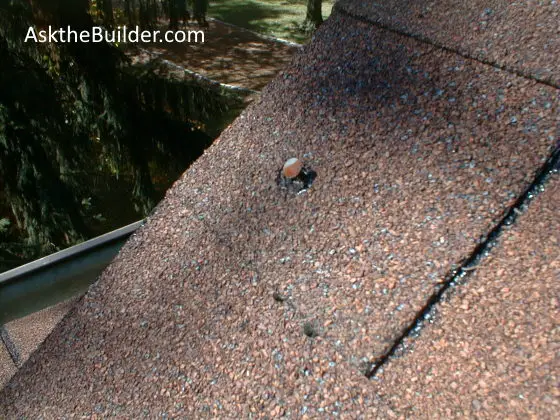Roofing Nails That Pop Up

A pesky roofing nail popping out on my own roof. Arrrggh!
This nail probably was driven very close to the horizontal seam of the sheets of plywood under the shingles.
DEAR TIM: Eight years ago, I had a new asphalt shingle roof installed on my 55-year-old home. Leaks recently started to appear in several areas of my home and upon inspection, roofing nails actually had backed out and popped through the shingles. Why did this happen? I hammered the nails back down and applied roofing cement over the holes. Is this the correct thing to do? Is there a permanent way to patch the holes in the face of the shingles? John D., Atlanta, GA
DEAR JOHN: Roofing nails that seem to defy gravity are more common than you might think. In fact, it has even happened on my own roof. There are all sorts of reasons why nails back out of seemingly solid wood, but perhaps the most common reason is that the nail did not get a good bite into the wood when it was first driven. It is vitally important that roofing nails of the correct length were used to secure the shingles. The sharp tip of the roofing nail should completely pass through and extend approximately 3/8 inch past the underside of the roof sheathing.
What type of roof sheathing was popular in the 1950's?
It is entirely possible that your roof sheathing might consist of numerous tongue and groove 1x6 boards. This was a very common roof sheathing product in the 1950's. Every 5.5 inches there is a horizontal seam where two 1x6s interlock. If the roofing nail happens to penetrate the sheathing along this seam, there is very little solid wood to hold the nail. In fact, the roofing nail can actually crack of the thin tongue along the seam. If this happens, there is virtually nothing holding onto the nail.
This same thing can happen on roofs that have large 4 x 8 pieces of plywood or oriented strandboard sheathing. Nails that hit weak spots in these products or along the seams where one sheet meets another are highly susceptible to backing out.
Does your roof and sheathing expand?
Each day and night your roof and the sheathing beneath it go through a heating and cooling cycle. Add to this the changes in humidity, and you can see that the wood sheathing not only expands and contracts but it can also do so with astonishing frequency. This movement can slowly and forcefully push a nail up and out of the wood. The movement is very slight each day, but it does indeed happen. In the most severe cases, as in yours and mine, the head of the nail actually breaks through the top layer of shingles. Many people have nails that have backed out, but they simply see a hump in a shingle.
How do you repair a roofing nail pop?
The repair method you followed will not be permanent. Since you did not relocate the nail, it continues to have minimal or no holding power. The nails should have been removed and relocated about one inch higher in an attempt to find solid wood. If you can enlist the help of someone, they might be able to go inside the attic and see the pesky nail as you pull it out. They can communicate with you and tell you which direction to go to get away from a seam, crack or a knot in the roof sheathing.
The asphalt cement you applied over the hole in the shingle is also not permanent. The sun's ultraviolet(UV) rays break down the asphalt and cause it to age prematurely. The colored ceramic granules that cover asphalt shingles, among other things, serve to shield the asphalt in your shingles from these harmful UV rays. At the very least while the asphalt cement was fresh, you might have collected some loose granules from a gutter to broadcast into the sticky asphalt cement.
I feel a better way to patch the hole is to do so from under the shingle. Cut a four by two inch rectangle of regular 15 pound felt paper and fold it into a two by two inch square. Lift the damaged shingle up and apply a half-teaspoon dab of asphalt cement directly over the nail shaft hole. Press the piece of felt paper into the fresh cement making sure the crease in the paper faces up towards the roof.
The shingle can now be laid back flat on the roof. If it is not flat, apply additional asphalt cement under the lower edge of the shingle and press down until the shingle behaves and lays flat. The hole in the surface of the shingle can be carefully patched with a small amount of asphalt cement. Liberally apply loose matching colored granules to the cement and press them into the sticky black goo. Once you are back on the ground I doubt you will be able to see the repaired hole.
When is the best time to work with shingles?
Repairing shingle leaks is very easy. The trick is to work with the shingles when they are warm. Cold, brittle shingles can crack easily. Use a wide, flat pry bar to break the seal between individual shingles. Slide the pry bar up under the shingle and it will eventually allow you to gently bend the bottom of the shingle up. Do not over bend the shingle as it can crack even if it is warm.
If you can't find any loose granules at your home, you can possibly get them for free at any business that sells shingles. They have thousands of them scattered on the floor or around the pallets where shingles are stored. Roofing manufacturers actually sell buckets of new granules if you need them in larger quantities.
Column 487
2 Responses to Roofing Nails That Pop Up